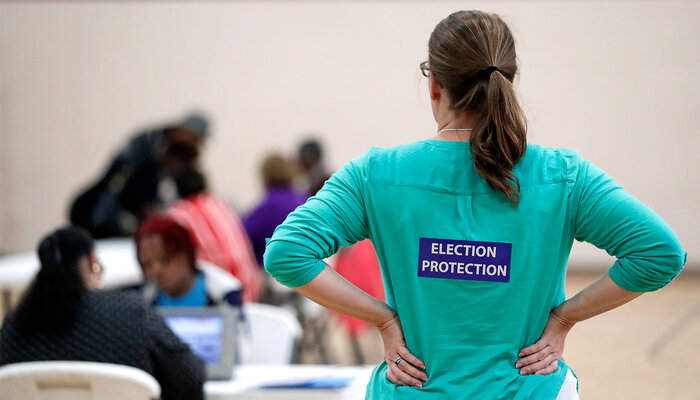Written and Published in Partnership with All Voting is Local.
Election observers, referred to as “political party observers” or “observers” in Arizona, are individuals who monitor voting locations and ballot counting sites. While election observers play an important role in providing transparency, they can also be a potential source of disruption and intimidation. For this reason, all states have a series of rules and constraints regarding who can serve as election observers and what they can do. Arizona’s rules on observers, which derive both from the state’s election code and from guidance issued by the secretary of state, are:
Appointment
- Under Arizona law, only the county chairperson of each political party represented on the ballot may appoint observers to voting locations.footnote1_w1WCwfEgjQzkND8dY8kWMeN-TQOyMkRfNeCcIVEJK4_daukWQVZ1AJW1 Ariz. Rev. Stat. § 16–590. See also Arizona Secretary of State, 2023 Arizona Elections Procedures Manual (AEPM), December 2023, 138, https://apps.azsos.gov/election/files/epm/2023/EPM_20231231_Final_Edits_to_Cal_1_11_2024.pdf. Only one observer may be appointed per voting location, unless the parties agree to allow more observers.footnote2_A6HnpjBy69OmXfk0BnOBSLBMjmtKD1Sx9gRTqhJoraI_zXJHg29ocHwm2 Ariz. Rev. Stat. § 16–590. See also AEPM.
- Observers may be appointed to Election Day voting locations, early voting locations, central counting places, or emergency voting centers.footnote3_A6HnpjBy69OmXfk0BnOBSLBMjmtKD1Sx9gRTqhJoraI_zT43sg9DzNyG3 Ariz. Rev. Stat. § 16–590. See also AEPM.
- Proceedings at central counting places may also be observed by up to three observers representing a candidate for nonpartisan office or representing a political committee supporting or opposing a ballot measure.footnote4_WOt563UF9uQDaYc3uvIwTNnYFH2O6xRZGxYaPzRwEM_nHZTPM1xfpbG4 Ariz. Rev. Stat. § 16–621(A). See also AEPM, 138.
- Arizona law requires observers to be Arizona residents and registered to vote in Arizona.footnote5_OzAlRAAKXAxxdC5cyPq7xqlceNvzDpuWCr0lehn06s_cZKeLkznuDbj5 Ariz. Rev. Stat. § 16–590(D). See also AEPM, 138.
- The county recorder or officer in charge of elections may require advance notice of names of observers, who must provide their credentials to poll workers at their assigned voting location.footnote6_PwCL96PGuusogU7K0yvqW1CFzIiGKcaowECHzVS2IY_ndXYxMmpCJ7n6AEPM, 139.
Role of Observers
- Observers monitor the election process without causing disruptions.footnote7_Nwumlwm2HLZOfv3Ji-wOPmnZNUj9fU9D6CS6lbMeY80_vNd9IeXsFJ527AEPM, 138–41.
- Observers can challenge a voter’s eligibility but must do so in writing with clear and convincing evidence.footnote8_JusPMWtUv1VcWSqu3g6RjW12KzYOUJVQ5225Dn3wsc4_f8YXNGDCkaO88AEPM, 194–96; and Arizona Secretary of State, “Guidance on Voting Location Conduct,” last accessed April 4, 2024, https://azsos.gov/elections/about-elections/guidance-voting-location-conduct. All challenges must be directed to poll workers.footnote9_XVrfxMwQeZz0spRftGNdOvB4468fvUJVYMgi9Nx8Ly0_lc58UDZc3vWa9AEPM and “Guidance.” Challenges to a voter’s qualifications for reasons such as the voter’s race, religion, language, appearance, national origin, or name are not permitted.footnote10_DUjH7Nftgbc7WcVvccP443fV8dQkmkdwyHFR2O8spN0_qlIAANulyTFc10 “Guidance.” More information on the rules and constraints on voter eligibility challenges can be found here.
Prohibited Activities
- Electioneering: It is illegal for anyone, including observers, to conduct campaign-related activities, known as electioneering, within 75 feet of any voting location.footnote11_9RbiTxqc52lcOW8dWpBcAlRRzwkPT1FViLxuuxLCXig_p003NRaIBvhV11 Ariz. Rev. Stat. §§16–411(H); Ariz. Rev. Stat. § 16–515; and Ariz. Rev. Stat. § 16–1018. Observers, as well as poll workers and election officials, are also prohibited from wearing clothing with a political message.footnote12_jaegVEzMnLhBUS07Ep7jzJtMjPYf6RW8PQJNFE-eWbg_y7UblOrELjaA12 Ariz. Rev. Stat. § 16–515(F).
- Photography and Video: It is illegal for anyone, including observers, to take photographs or videos while within 75 feet of any voting location.footnote13_iX5jymd8k1ttKyXV309hWd3IkfKMFoEcjWh3ouHJoj0_fhKQXn8H0kcK13 Ariz. Rev. Stat. § 16–515(G)-(H); and Ariz. Rev. Stat. § 16–1018(4).
- Carrying Firearms: It is illegal for any private citizen, including observers, to carry a firearm within 75 feet of any voting location.footnote14_JkTt5JrTOWUhDWa8j1V9uj97r3NdwUMYMSv3t9PJGU_zj5gjPCNoFG414 Ariz. Rev. Stat. § 13–3102(A)(11). See also AEPM, 182.
- Obstruction: Observers may not obstruct poll workers or the voting process.footnote15_HqMDN2Fs6T3PS1-yHL9ECWN850okzU3jJuqyFlpl96c_xMYzy2eGkJTw15 “Guidance.” See also AEPM, 140–41.
- Voter Interaction: Interacting or talking with voters within 75 feet of a voting location, including offering assistance to voters, is not permitted for observers.footnote16_qVX5Gx7zaEQIb-wRVp9CALjhF1cJm09-PUhEbAi8zY_tX8GVFv6kStf16 “Guidance.” See also AEPM, 140–41.
- Election Worker Interaction: Observers who have questions or objections about proceedings should raise them to the designated point of contact and not to any other election worker. Observers are not entitled to interrogate election workers, hover over them when asked to step back, or demand that workers enforce the rules.footnote17_UmbKjxJa8fdT333KT6SvF4OCmBbGrdwszfKgAtgywY_ue8zXp1HDubV17AEPM, 140.
- Intimidation or Influence: State law specifically prohibits observers from attempting to intimidate or influence a voter.footnote18_IPbtLEy30PZkHs9MFPLZ3AOUj9dKfJuYEI6gtXepM_vgvrtXsZ7u9718 “Guidance;” and AEPM, 140. Intimidation can include, but is not limited to, raising one’s voice or taunting a voter, blocking entrances, following voters around, impersonating law enforcement (including wearing official-looking apparel), raising frivolous challenges, or communicating about possible voter fraud in an intimidating manner.footnote19_EvRa5bS5XNtWBWPXiBcCep4pTpLYDG-NZkMrsIKMMg_gqUhHlffJF9X19AEPM, 182–83.
- Touching Election Materials: Observers cannot touch or handle election materials.footnote20_T8r99XZc8K0Fof5JO14U2X586Sw27H8KLxlIblChA_eDSBCmt15jX720AEPM, 140.
- Disobeying Instructions: When poll workers and election officials give lawful instructions, observers must follow them.footnote21_awhYocECPpjXFPGUcrUSgk7Rebcpxj7lWUdz1qOiTw_z1HDSNbeVxuA21 “Guidance.” See also AEPM, 140–41
Federal and state laws strictly prohibit all people, including observers, from engaging in voter intimidation. Any action that makes a voter feel intimidated, threatened, or coerced (including any effort to prevent a voter from registering to vote, voting, or voting for or against any candidate or ballot measure) could constitute voter intimidation, regardless of whether it breaks a specific rule.footnote22_fQkzWAxnlgoGEtY7gIa90V5pTR-8f9Ko1aXaCAnE-I_xTRtrDMuXnZm22 18 U.S.C. §§ 241, 594; 52 U.S.C. § 10101(b); and Ariz. Rev. Stat. § 16–1013. More information on the federal and state laws that protect Arizona voters from intimidation can be found here.
Removal
- Arizona’s secretary of state has expressly advised that election workers may remove observers from voting locations if they break the rules or fail to follow instructions, which is a very broad authority.footnote23_1RK-SctIMsX6c9PpaWmIkAp9BwhWvEy7fS32qOKIBGY_hAJCtTHHDVAI23AEPM, 139, 141; and “Guidance."
- Poll workers and election officials should remove observers for failing to comply with a request to stop an activity that interferes with the election process, election staff, or poll workers or violates state, federal, or tribal law (if applicable).footnote24_U99R1tkHQWLoCCUMwL3eZvNa4zzBc3YHhA7WUk0WA8_jOpyuRrLUUC924AEPM, 139, 141; and “Guidance.”
- Any observer who engages in prohibited activities may also face criminal charges.
- Poll workers should inform the officer in charge of elections of difficult situations involving disruptive people, including observers. Inspectors and marshals may contact law enforcement for assistance but should use sound judgment in deciding whether doing so is necessary.footnote25_o9uZ4aAZokqg1NSl3BS2c0Nnp62SHMxBLvQpb1qYNU_wnXEj9xudLXS25AEPM, 182.
End Notes
-
footnote1_w1WCwfEgjQzkND8dY8kWMeN-TQOyMkRfNeCcIVEJK4_daukWQVZ1AJW
1
Ariz. Rev. Stat. § 16–590. See also Arizona Secretary of State, 2023 Arizona Elections Procedures Manual (AEPM), December 2023, 138, https://apps.azsos.gov/election/files/epm/2023/EPM_20231231_Final_Edits_to_Cal_1_11_2024.pdf.
-
footnote2_A6HnpjBy69OmXfk0BnOBSLBMjmtKD1Sx9gRTqhJoraI_zXJHg29ocHwm
2
Ariz. Rev. Stat. § 16–590. See also AEPM.
-
footnote3_A6HnpjBy69OmXfk0BnOBSLBMjmtKD1Sx9gRTqhJoraI_zT43sg9DzNyG
3
Ariz. Rev. Stat. § 16–590. See also AEPM.
-
footnote4_WOt563UF9uQDaYc3uvIwTNnYFH2O6xRZGxYaPzRwEM_nHZTPM1xfpbG
4
Ariz. Rev. Stat. § 16–621(A). See also AEPM, 138.
-
footnote5_OzAlRAAKXAxxdC5cyPq7xqlceNvzDpuWCr0lehn06s_cZKeLkznuDbj
5
Ariz. Rev. Stat. § 16–590(D). See also AEPM, 138.
-
footnote6_PwCL96PGuusogU7K0yvqW1CFzIiGKcaowECHzVS2IY_ndXYxMmpCJ7n
6
AEPM, 139.
-
footnote7_Nwumlwm2HLZOfv3Ji-wOPmnZNUj9fU9D6CS6lbMeY80_vNd9IeXsFJ52
7
AEPM, 138–41.
-
footnote8_JusPMWtUv1VcWSqu3g6RjW12KzYOUJVQ5225Dn3wsc4_f8YXNGDCkaO8
8
AEPM, 194–96; and Arizona Secretary of State, “Guidance on Voting Location Conduct,” last accessed April 4, 2024, https://azsos.gov/elections/about-elections/guidance-voting-location-conduct.
-
footnote9_XVrfxMwQeZz0spRftGNdOvB4468fvUJVYMgi9Nx8Ly0_lc58UDZc3vWa
9
AEPM and “Guidance.”
-
footnote10_DUjH7Nftgbc7WcVvccP443fV8dQkmkdwyHFR2O8spN0_qlIAANulyTFc
10
“Guidance.”
-
footnote11_9RbiTxqc52lcOW8dWpBcAlRRzwkPT1FViLxuuxLCXig_p003NRaIBvhV
11
Ariz. Rev. Stat. §§16–411(H); Ariz. Rev. Stat. § 16–515; and Ariz. Rev. Stat. § 16–1018.
-
footnote12_jaegVEzMnLhBUS07Ep7jzJtMjPYf6RW8PQJNFE-eWbg_y7UblOrELjaA
12
Ariz. Rev. Stat. § 16–515(F).
-
footnote13_iX5jymd8k1ttKyXV309hWd3IkfKMFoEcjWh3ouHJoj0_fhKQXn8H0kcK
13
Ariz. Rev. Stat. § 16–515(G)-(H); and Ariz. Rev. Stat. § 16–1018(4).
-
footnote14_JkTt5JrTOWUhDWa8j1V9uj97r3NdwUMYMSv3t9PJGU_zj5gjPCNoFG4
14
Ariz. Rev. Stat. § 13–3102(A)(11). See also AEPM, 182.
-
footnote15_HqMDN2Fs6T3PS1-yHL9ECWN850okzU3jJuqyFlpl96c_xMYzy2eGkJTw
15
“Guidance.” See also AEPM, 140–41.
-
footnote16_qVX5Gx7zaEQIb-wRVp9CALjhF1cJm09-PUhEbAi8zY_tX8GVFv6kStf
16
“Guidance.” See also AEPM, 140–41.
-
footnote17_UmbKjxJa8fdT333KT6SvF4OCmBbGrdwszfKgAtgywY_ue8zXp1HDubV
17
AEPM, 140.
-
footnote18_IPbtLEy30PZkHs9MFPLZ3AOUj9dKfJuYEI6gtXepM_vgvrtXsZ7u97
18
“Guidance;” and AEPM, 140.
-
footnote19_EvRa5bS5XNtWBWPXiBcCep4pTpLYDG-NZkMrsIKMMg_gqUhHlffJF9X
19
AEPM, 182–83.
-
footnote20_T8r99XZc8K0Fof5JO14U2X586Sw27H8KLxlIblChA_eDSBCmt15jX7
20
AEPM, 140.
-
footnote21_awhYocECPpjXFPGUcrUSgk7Rebcpxj7lWUdz1qOiTw_z1HDSNbeVxuA
21
“Guidance.” See also AEPM, 140–41
-
footnote22_fQkzWAxnlgoGEtY7gIa90V5pTR-8f9Ko1aXaCAnE-I_xTRtrDMuXnZm
22
18 U.S.C. §§ 241, 594; 52 U.S.C. § 10101(b); and Ariz. Rev. Stat. § 16–1013.
-
footnote23_1RK-SctIMsX6c9PpaWmIkAp9BwhWvEy7fS32qOKIBGY_hAJCtTHHDVAI
23
AEPM, 139, 141; and “Guidance."
-
footnote24_U99R1tkHQWLoCCUMwL3eZvNa4zzBc3YHhA7WUk0WA8_jOpyuRrLUUC9
24
AEPM, 139, 141; and “Guidance.”
-
footnote25_o9uZ4aAZokqg1NSl3BS2c0Nnp62SHMxBLvQpb1qYNU_wnXEj9xudLXS
25
AEPM, 182.





